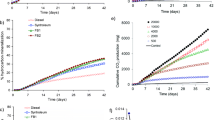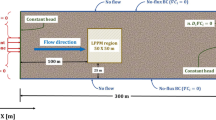Abstract
The effects of permeability variability on uncertainty of the results of a hydrocarbon biodegradation model are addressed. The model includes saturated and unsaturated flow, multi-species transport, heat transport, and bacterial-growth processes. A stochastic approach was used in the uncertainty analysis. Sensitivity analyses were conducted, taking into consideration the effects of heterogeneity. The Monte Carlo method was used, with permeability as the input stochastic variable. Results showed that uncertainty increases with time. This can lead to difficulties regarding cleanup decision making such as predicting the timeframe to reach an aquifer cleanup goal. It was not possible to replace the heterogeneous system with a homogeneous one through the use of effective parameters that preserve an equivalent behavior of the two systems. Effective permeability is space and time dependent and also depends on values of bioactivity parameters. The study also emphasized the importance of accurately measuring certain bacterial parameters, namely, maximum substrate uptake rate for degradation and cell yield coefficient. Uncertainties regarding nutrient and oxygen uptake and saturation parameters were less important for the current application.
Résumé
Il est question de l’influence de la variabilité de la perméabilité sur l’incertitude des résultats d’un modèle de biodégradation des hydrocarbures. Le modèle prend en compte l’écoulement en zones saturée et insaturée, le transport de plusieurs espèces chimiques, le transfert de chaleur ainsi que les processus de développement bactérien. L’analyse d’incertitude a été déterminée par une approche stochastique. Des tests de sensibilité ont été réalisés en tenant compte des effets de l’hétérogénéité. La méthode de Monte Carlo a été utilisée avec la perméabilité comme variable d’entrée aléatoire. Les résultats ont montré que l’incertitude augmente avec le temps. Ceci peut conduire à des inconvénients en ce qui concerne les projets de dépollution, comme par exemple pour déterminer un cadre temporel permettant d’atteindre un objectif de dépollution d’un aquifère. Il n’a pas été possible, en utilisant des paramètres efficaces qui auraient représenté un comportement équivalent dans les deux systèmes, de remplacer le système hétérogène par un système homogène. La perméabilité efficace est spatialement et temporellement dépendante et est également influencée par les valeurs des paramètres de bio activité. L’étude souligne aussi l’importance de mesurer avec précision certains paramètres bactériens, en particulier, le taux maximum de consommation de substrat pour la dégradation et le coefficient de rendement des cellules. Les incertitudes concernant la consommation et la saturation en oxygène et en nutriments n’étaient pas si importantes dans cette étude.
Resumen
Se apuntan los efectos de la variabilidad de la permeabilidad en la incertidumbre de los resultados de un modelo de biodegradación de hidrocarburos. El modelo incluye el flujo saturado y no saturado, el transporte multi-específico, el transporte de calor y los procesos de crecimiento bacteriano. Se usó una aproximación estocástica para el análisis de incertidumbre. Se llevaron a cabo análisis de sensibilidad, teniendo en cuenta los efectos de la heterogeneidad. Se usó el método Monte Carlo, con la permeabilidad como variable estocástica de partida. Los resultados mostraron que la incertidumbre crece con el tiempo. Esto puede dar lugar a dificultades a la hora de tomar decisiones en cuanto al tratamiento de limpieza, tales como la predicción del tiempo que se tarda en alcanzar los objetivos de recuperación de un acuífero. No fue posible reemplazar el sistema heterogéneo con otro homogéneo mediante el uso de parámetros efectivos que conserven un comportamiento equivalente de ambos sistemas. La permeabilidad efectiva depende del espacio y el tiempo y también de los valores de los parámetros de bioactividad. El estudio también enfatiza la importancia de la precisión en las medidas de ciertos parámetros bacterianos, concretamente, el rango de consumo máximo de sustrato para la degradación y coeficiente de rendimiento celular. Las incertidumbres que afectan a los nutrientes y a los valores de oxígeno y parámetros de saturación fueron menos importantes para la aplicación llevada a cabo.








Similar content being viewed by others
Notes
Reproduced from Journal of Contaminant Hydrology, 51, El-Kadi AI, Modeling hydrocarbon biodegradation in tidal aquifers with water-saturation and heat inhibition effects, pp97–125, Copyright (2001), with permission from Elsevier.
References
Albrechtsen H-J (1994) Distribution of bacteria, estimated by a viable count method, and heterotrophic activity in different size fractions of aquifer sediment. Geomicrobiol J 12:253–264
Criminisi A, Tucciarelli T, Karatzas GP (1997) A methodology to determine optimal transitivity measurement locations in groundwater quality management models with scarce field information. Water Resour Res 33(6):1265–1274
Devlin JF, Barker JF (1994) A semipassive nutrient injection scheme for enhanced in situ bioremediation. Ground Water 32:374–380
El-Kadi AI (2001) Modeling hydrocarbon biodegradation in tidal aquifers with water-saturation and heat inhibition effects. J Contam Hydrol 51:97–125
El-Kadi AI, Brutsaert W (1985) Applicability of effective parameters for unsteady flow in heterogeneous aquifers. Water Resour Res 21(2):183–198
El-Kadi AI, Williams SA (2000) Generating two-dimensional fields of autocorrelated, normally distributed parameters by the matrix decomposition technique. Ground Water 38:530–532
Essaid HI, Bekins BA, Godsy EM, Warren E, Baedecker MJ, Cozzarelli IM (1995) Simulation of aerobic and anaerobic biodegradation processes at a crude oil spill site. Water Resour Res 31:3309–3327
Essaid HI, Cozzarelli IM, Eganhouse RP, Herkelrath WN, Bekins BA, Delin GN (2003) Inverse modeling of BTEX dissolution and biodegradation at the Bemidji, MN crude-oil spill site. J Contam Hydrol 67:269–299
Fetter CW (2001) Applied hydrogeology, 4th edn. Prentice Hall, Englewood Cliffs, NJ
Fredrickson JK, Garland TR, Hicks RJ, Thomas JM, Li SW, McFadden KM (1989) Lithotrophic and heterotrophic bacteria in deep subsurface sediment and their relation to sediment properties. Geomicrobiol J 7:53–66
Gelhar LW, Axness CL (1983) Three-dimensional stochastic analysis of macrodispersion in aquifers. Water Resour Res 19:161–180
Harter T, Yeh T-CJ (1996) Conditional stochastic analysis of solute transport in heterogeneous, variably saturated soils. Water Resour Res 32:1597–1609
Jaekel U, Vereecken H (1997) Renormalization group analysis of macrodispersion in a directed random flow. Water Resour Res 33:2287–2299
James A, Oldenburg CM (1997) Linear and Monte Carlo uncertainty analysis for subsurface contaminant transport simulation. Water Resour Res 33:2495–2508
Kim CP, Striker JNM (1996) Influence of spatially variable soil hydraulic properties and rainfall intensity on the water budget. Water Resour Res 32:1699–1712
Levine SN, Ghiorse WC (1990) Analysis of environmental factors affecting abundance and distribution of bacteria, fungi and protozoa in subsurface sediment of Upper Atlantic Coastal Plain, USA. In: Fliermans CB, Hazen TC (eds) Proceedings of the First International Symposium on Microbiology of the Deep Subsurface, Westinghouse Savannah River Co., Aiken, SC, pp 5-31–5-43
Lu GP, Zheng CM, Wolfsberg A (2005) Effect of uncertain hydraulic conductivity on the simulated fate and transport of BTEX compounds at a field site. J Environ Eng ASCE 131:767–776
McNab WW (2001) A Monte Carlo simulation method for assessing biotransformation effects on groundwater fuel hydrocarbon plume lengths. Comput Geosci 27:3–42
Miralles-Wilhelm F, Gelhar LW, Kapoor V (1997) Stochastic analysis of oxygen-limited biodegradation in three-dimensionally heterogeneous aquifers. Water Resour Res 33:1251–1264
Peter A, Steinbach A, Liedl R, Ptak T, Michaelis W, Teutsch G (2004) Assessing microbial degradation of o-xylene at field-scale from the reduction in mass flow rate combined with compound-specific isotope analyses. J Contam Hydrol 71:127–154
Richards LA (1931) Capillary conduction of liquids in porous mediums. Physics 1:318–333
Scholl MA (2000) Effects of heterogeneity in aquifer permeability and biomass on biodegradation rate calculations: results from numerical simulations. Ground Water 38:702–712
Thornton SF, Lerner DN, Banwart SA (2001) Assessing the natural attenuation of organic contaminants in aquifers using plume-scale electron and carbon balances: model development with analysis of uncertainty and parameter sensitivity. J Contam Hydrol 53:199–232
van Genuchten MTh (1978) Calculating the unsaturated hydraulic conductivity with a new closed-form analytical model. 78-WR-08. Water Resources Program, Department of Civil Engineering, Princeton University, Princeton, NJ
Vollmayr H, Kleint F, Schuurmann G (1997) Discrete molding of water and pesticide movement in soil. Water Resour Res 33:1743–1747
Voss CI (1984) A finite-element simulation model for saturated-unsaturated, fluid-density-dependent ground-water flow with energy transport or chemically-reactive single-species solute transport. Water-Resources Investigations Report 84-4369. US Geological Survey, Reston, VA
Acknowledgements
This research was funded by the US Geological Survey (WRRIP grant no. 1434-HQ-96GR02666). This is contributed paper CP-2006-12 of the Water Resources Research Center at the University of Hawaii at Manoa.
Author information
Authors and Affiliations
Corresponding author
Appendix: bacterial-growth model
Appendix: bacterial-growth model
The formulation summarized here is based on El-Kadi (2001 Footnote 1) and is added for the sake of completeness. For a single population, bacterial growth is simulated using the following equation:
where X is the biomass concentration (M/L 3), μ is its specific growth (1/T), d is its specific death/regeneration rate (1/T), and t is time (T). For a single biodegradation process, the specific growth rate is estimated from
where Y is the cell-yield coefficient (M bacteria/M substrate) and v (1/T) is the substrate uptake rate. The latter is estimated from a variation of Monod kinetics, where either multiple or minimum Monod formulation can be used. The minimum Monod formulation can be expressed as
where
In these equations, i is the solute index, m is the total number of solutes, C i is the solution concentration (M/L 3), K i is the saturation parameter for growth limitation regarding species i (M/L 3), and V max is the maximum substrate uptake rate (1/T). In this equation, i=H for hydrocarbon, N for nitrogen, P for phosphorous, and O for oxygen. In Eqs. (3 and 4), I nc and I cb are the noncompetitive and competitive inhibition factors, respectively. The variable n b represents the number of inhibition factors, which can include water content and temperature, among other factors. These effects on bacterial growth are assumed to follow a three-parameter modified Gaussian distribution form. For water content, the expression reads:
where θ is the water content, θ m is the optimal value of the water content for bacterial growth, σ θ is the standard deviation of the distribution, and a θ is the maximum inhibition value. A similar expression is used for temperature, with T, the temperature in degrees Celsius, replacing θ in the equation. A value of unity for either I θ or I T is obtained at θ=θ m or T=T m, respectively.
The source/sink term (M/L 3 /T) for a species is defined by
where β i (dimensionless) is the uptake coefficient of solute i and is taken as unity for the primary substrate. For other substrates, it is determined by the stoichiometry of the reaction, which is equal to the ratio of the mass of solute i to that of the primary substrate. In this equation, i=H for hydrocarbon, N for nitrogen, P for phosphorous, and O for oxygen.
The fate of the dissolved hydrocarbon is analyzed by solving the convection/dispersion equation, with the appropriate source/sink term. For a trapped product, the change in concentration is limited to product uptake by the bacteria:
where C H and q H are the hydrocarbon concentration and the uptake coefficient of hydrocarbon, respectively, as estimated from Eq. (6). For example, C H could represent the concentration of the total petroleum hydrocarbon, as measured in the sample, without differentiating between the dissolved or free product.
Rights and permissions
About this article
Cite this article
El-Kadi, A.I. Parameter sensitivity of a hydrocarbon biodegradation model under uncertainty of permeability. Hydrogeol J 15, 339–350 (2007). https://doi.org/10.1007/s10040-006-0101-9
Received:
Accepted:
Published:
Issue Date:
DOI: https://doi.org/10.1007/s10040-006-0101-9




